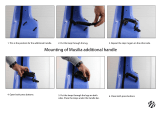
Creating a Patch
10
Parameter Value/Explanation
Patch MIDI 1–8
* When the Patch MIDI screen is displayed, pressing the [ENTER] button transmits all
of the MIDI messages that are assigned in Patch MIDI 1–8.
Ch
Species the transmit channel for MIDI messages.
OFF (not transmitted), 1–16
LSB
MSB
Species whether bank select messages are transmitted when
you switch patches.
* It is not possible to turn on only Bank LSB.
* Not transmitted if PC is OFF.
* It is not possible to transmit only bank select. Bank select is
always transmitted in conjunction with program change.
OFF Not transmitted.
0–127 The specied value is transmitted.
PC
Species whether a program change is transmitted when you
switch patches.
OFF Not transmitted.
1–128 The specied value is transmitted.
Ctl1–2 CC#
Species whether a control change is transmitted when you
switch patches.
OFF Not transmitted.
CC#000–127 The specied control change is transmitted.
Ctl1–2 Val
Species the value of the control change.
0–127
CTL/EXP
Parameter Value/Explanation
BANK, MUTE, NUMBER 1–5, CTL IN 1–2
* If the Preference (p. 12) parameter is set to SYS, the screen indicates (SYS).
Func
Specify the function of the [BANK] switch, [MUTE] switch, number
switches [1]–[5], and footswitches connected to the CTL IN jack.
* If Patch Slct Mod (p. 12) is set to MODE 2, BnkM/BnkD/BnkU
wait for the bank to be selected.
OFF Pressing the switch does nothing.
MemM
Switches between memory mode and manual
mode.
Mute [MUTE] switch
BnkM
Change banks
5 1
0
2
0
3
0
4
0
5
0
1...
5 Hold down for two seconds to switch
between memory/manual modes
GrpD, GrpU
Change groups
5 GrpD: 8
0
7
0
6
0
...1
0
8...
5 GrpU: 1
0
2
0
3
0
...8
0
1...
BnkD, BnkU
Change banks
5 BnkD: 5
0
4
0
3
0
2
0
1
0
5...
5 BnkU: 1
0
2
0
3
0
4
0
5
0
1...
MemD, MemU
Change patches
5 MemD: 855
0
111
5 MemU: 111
0
855
Num1–5 Number switches [1]–[5]
Ctl1–4
A control signal is sent from the
corresponding EXT CTL jack CTL 1/2, 3/4.
BPM Tap the switch to control the master BPM.
Min, Max
Specify the values that are sent when the switch is pressed (Max)
and released (Min).
* These settings are available only when Func is Ctl1–4.
OFF Sends “o”
ON Sends “on”
Mod
Species the operation of the switch.
* These settings are available only when Func is Ctl1–4.
MOM
Normally o; on only while the switch is being
operated.
TGL
Alternates on/o each time the switch is
operated.
Parameter Value/Explanation
EXP IN
* If the Preference (p. 12) parameter is set to SYS, the screen indicates (SYS).
Func
Specify the function of the expression pedal connected to the
CTL IN jack.
OFF Operating the pedal does nothing.
BPM Use the pedal to control Master BPM.
Min, Max
Specify the values that are sent when the pedal is advanced (Max)
and returned (Min).
* This can be set only if Func is BPM.
(Min) 20–500, (Max) 20–500
Assign (A) 1–8
Sw
Turns the assignment on/o.
ON, OFF
Src
Species the controller (source).
CTL1, 2 A footswitch connected to a CTL IN jack
Mute [MUTE] switch
Bank [Bank] switch
Num1–5 Number switches [1]–[5]
CNum Currently selected number switch
EXP
An expression pedal connected to a CTL IN
jack.
INT
Internal pedal
The virtual expression pedal
will begin operating when
started by the specied trigger
(Trig), modifying the parameter
specied by “Target.”
WAV
Wave pedal
The virtual expression pedal will cyclically
modify the parameter specied by “Target” in
a xed wave form.
CC000–127
Control change number from an external MIDI
device
Mod
Species the operation of the controller.
MOM
The value will normally be o (minimum
value), and will be on (maximum value) only
while the control is being operated.
TGL
The value will toggle between o (minimum)
and on (maximum) each time the control is
operated.
Cate Selects the Target category.
For details, refer to
“Target List” (p. 11).
Target Species the parameter to be controlled.
Min
Max
Species the range of change for the
parameter. The values will depend on
the parameter that’s assigned by Target.
Ch
Species the transmit channel for control changes.
1–16
CC#
Species the controller number that is transmitted.
000–127
Act L
Act H
Within the operating range of the source, this species the range
that will control the target parameter.
(L) 0–126
(H) 1–127
The target parameter will be controlled within
the range specied. Normally, you should
leave Act L at “0” and Act H at “127.”
Trig
Species how the motion of the internal pedal will be triggered.
PAT When the patch is switched
ExpL, ExpM, ExpH
When an expression pedal connected to a CTL
IN jack (EXP) enters the following status
ExpL Minimum
ExpM
Advance the pedal through the
central value
ExpH Maximum
CTL1, 2 A footswitch connected to a CTL IN jack
Mute [MUTE] switch
Bank [BANK] switch
Num1–5 Number switches [1]–[5]
CNum Currently selected number switch
CC000–127
When the specied controller number is
received
Tim
Species the time over which the internal pedal will move from
the released (heel) position to the depressed (toe) position.
0–100
*1
*1
*2
*2




















